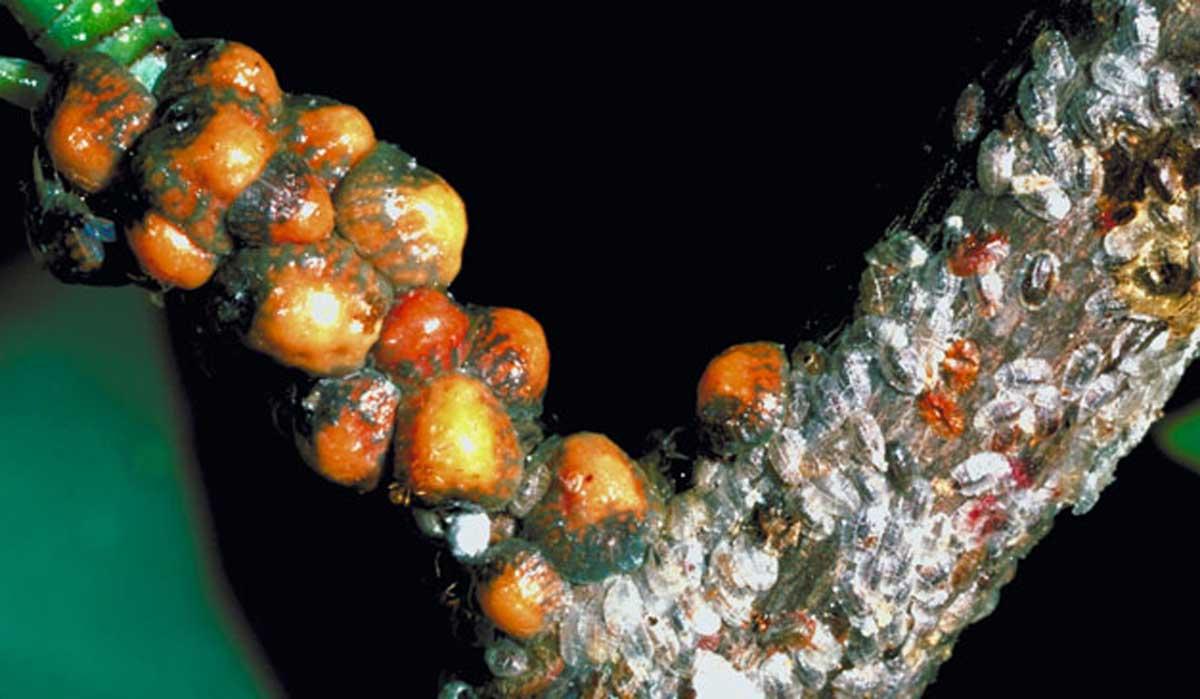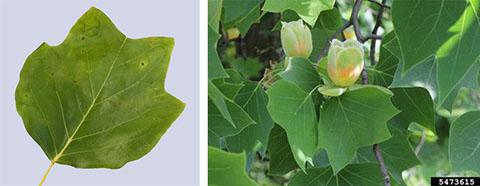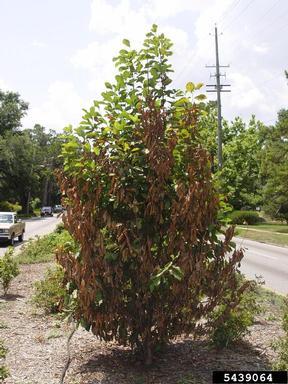Tree Health: Tuliptree Scale
By Hannah Moore

As we enter the fall season and leaves begin to turn in our cities, towns, and woodlands, there is one tree that is especially noteworthy: the tulip-poplar. One of the first trees to change its colors, tulip-poplars (Liriodendron tulipifera) enrich the fall foliage of Kentucky with their reliably iconic yellow leaves. The importance of the tulip-poplar cannot be overstated; as a tall, straight, and fairly fast-growing Eastern hardwood, it is a major timber tree, as well as a popular and majestic landscaping and street tree.

LEFT: Single tulip poplar leaf for identification. RIGHT: Tulip poplar in bloom.
One of the appeals of incorporating tulip-poplars into urban settings is that they are relatively pest and disease-resistant. It is, however, susceptible to some pests, among which is the tuliptree scale. The tuliptree scale is a large soft scale insect that primarily infests tulip-poplars and magnolias (both in the Magnoliaceae family), attaching itself to branches and twigs where it will feed on the tree host’s nutrients and produce large amounts of honeydew, its sugary excrement. As the honeydew accumulates on branch and leaf surfaces, it promotes the growth of dense, black sooty mold, which can inhibit the tree’s photosynthetic functions and diminish its aesthetic value. Though they do not cause significant harm to large mature trees, the scales can damage and even kill young trees and saplings.

Damage caused by tuliptree scale on a lily magnolia.
Tuliptree scales are widespread and native to the Eastern United States, and often occur in numbers too low to do significant damage to trees, especially in natural settings. However, young trees in close proximity to other young trees (of any tuliptree scale host species) are much more susceptible to harmful infestations, especially in nurseries or urban landscapes. When choosing trees to plant, vigilant inspection for tuliptree scale and early treatment of the insects when necessary are very important. Scale infestations can impact the value and marketability of a tree, and if infested trees are planted with or near other tulip-poplars, magnolias, or other susceptible hosts, the scales can spread to neighboring trees.
Management: Prevention and Control
Keeping a close watch on your trees for signs of tuliptree scales (as well as other pests or signs of distress) can go a long way in preventing infestations or damage, but frequently checking twigs, limbs, and leaves isn’t always easy or convenient. One thing that can be a good indicator of a scale issue is ants: if you notice a moderate or significant number of ants moving up and down your tree’s trunk, it might be time to do a more thorough check for scales. Several species of ants have a mutualistic relationship with scale insects: the ants feed on the honeydew produced by the scales, and will often “tend” scale populations by defending them from predators or even building protective structures around them; scale populations being tended by ants have survival rates that are up to 50% higher than those without the protection and defense of ants.
Natural predators, including lady beetles, predatory mites, and parasitoid wasps, are very effective at keeping tuliptree scale populations in check. Attracting natural predators of the tuliptree tree scale is often as simple as planting flowering plants near or around susceptible trees. One of the most important ways of preventing and managing tuliptree scale infestations is proper tree care. A tree that is stressed is much more susceptible to disease and pest infestations. Properly caring for your tree includes mulching, pruning, providing appropriate space for growth, and watering during dry spells.*

Other common scale insect pests in our region. LEFT: Oystershell scale; CENTER: Calico scale; RIGHT: Hemlock elongate scale.
* [For more information about tree care, see other TreeTalk articles “Tree Care: The Planting Hole” (Fall 2016), “Tree Care: Mulching” (Summer 2016), and “Plant Health: Landscape Sanitation” (Fall 2015)]
Photography
-
Tuliptree scale (Toumeyella liriodendri) (Gerald J. Lenhard, Louisiana State University, Bugwood.org)
-
Tulip poplar leaf (Max Hammer, personal photo)
-
Yellow poplar in bloom (Rob Routledge, Sault College, Bugwood.org)
-
Tuliptree scale damage (Chazz Hesselein, Alabama Cooperative Extension System, Bugwood.org)
-
Oystershell scale (Whitney Cranshaw, Colorado State University, Bugwood.org)
- Calico scale (Raymond Gill, California Department of Food and Agriculture, Bugwood.org)
- Hemlock elongate scale (Lorraine Graney, Bartlett Tree Experts, Bugwood.org)
About the Author
Hannah Moore is a graduate of the Natural Resources and Environmental Science program at the University of Kentucky. As a student, Hannah focused much of her time developing her knowledge of entomology through both her courses and fieldwork with faculty members.
